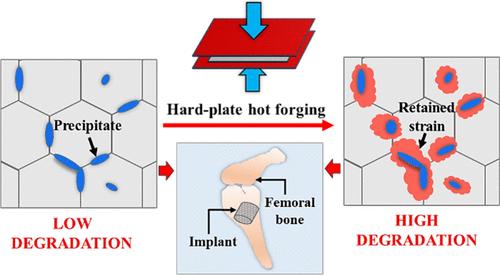Effect of Thermomechanical Processing Induced Retained Strain on In Vitro, In Vivo Biodegradation Response and Cytocompatibility of Mg Alloy
IF 5.5
2区 医学
Q2 MATERIALS SCIENCE, BIOMATERIALS
引用次数: 0
Abstract
The implications of retained strain on in vitro and in vivo degradation behavior as well as cytocompatibility of the Mg–4Zn–0.5Ca–0.8Mn alloy is comprehensively studied. The retained strain is induced in homogenized specimens by hard-plate hot forging (HPHF) at a temperature (523 K) lower than the recrystallization temperature of the alloy. The retained strain generated during deformation process deteriorated the corrosion response of the deformed alloy as compared to its homogenized counterpart. The strained area of deformed specimen with high dislocation density promoted defect generation (oxygen vacancies) in the film and facilitated preferential migration of ions, consequently leading to formation of a nonuniform product film with low protectiveness. In addition to strain magnitude, the distribution of retained strain also influenced the product film properties in the deformed specimens. An even distribution of retained strain improved the uniformity of the product film to certain extent by providing greater film coverage, resulting in higher film resistance. After 24 h of immersion, the protectiveness of the film was further improved in this specimen due to annihilation of defects through homogeneous ionic migration, which led to the development of a uniform and stable film that restricted further ionic diffusion. The dissolution of Zn(OH)2 into Zn2+ ions was promoted at lower pH, resulting in enhanced antimicrobial activity in the specimen with the lowest degradation. Besides, the specimen with stable product film not only minimized the rate of further degradation but also served as an interface for new bone growth, as evident from in vivo studies.

热机械加工引起的残余应变对镁合金体外、体内生物降解反应和细胞相容性的影响
本文全面研究了残余应变对 Mg-4Zn-0.5Ca-0.8Mn 合金体外和体内降解行为以及细胞相容性的影响。在低于合金再结晶温度(523 K)的温度下,通过硬板热锻(HPHF)在均质试样中诱导保留应变。与同质化合金相比,变形过程中产生的残余应变会恶化变形合金的腐蚀反应。变形试样的应变区域具有较高的位错密度,这促进了膜中缺陷的产生(氧空位),并有利于离子的优先迁移,从而导致形成保护性较低的不均匀产品膜。除应变大小外,保留应变的分布也会影响变形试样的产品薄膜特性。均匀分布的保留应变在一定程度上改善了产品薄膜的均匀性,提供了更大的薄膜覆盖范围,从而获得更高的薄膜抗性。浸泡 24 小时后,该试样的薄膜保护性进一步提高,原因是均匀的离子迁移湮灭了缺陷,从而形成了一层均匀稳定的薄膜,限制了离子的进一步扩散。在较低的 pH 值下,Zn(OH)2 会溶解成 Zn2+ 离子,从而提高了降解度最低的试样的抗菌活性。此外,具有稳定产品膜的试样不仅能最大限度地降低进一步降解的速度,而且还能作为新骨生长的界面,这一点在体内研究中也得到了证实。
本文章由计算机程序翻译,如有差异,请以英文原文为准。
求助全文
约1分钟内获得全文
求助全文
来源期刊

ACS Biomaterials Science & Engineering
Materials Science-Biomaterials
CiteScore
10.30
自引率
3.40%
发文量
413
期刊介绍:
ACS Biomaterials Science & Engineering is the leading journal in the field of biomaterials, serving as an international forum for publishing cutting-edge research and innovative ideas on a broad range of topics:
Applications and Health – implantable tissues and devices, prosthesis, health risks, toxicology
Bio-interactions and Bio-compatibility – material-biology interactions, chemical/morphological/structural communication, mechanobiology, signaling and biological responses, immuno-engineering, calcification, coatings, corrosion and degradation of biomaterials and devices, biophysical regulation of cell functions
Characterization, Synthesis, and Modification – new biomaterials, bioinspired and biomimetic approaches to biomaterials, exploiting structural hierarchy and architectural control, combinatorial strategies for biomaterials discovery, genetic biomaterials design, synthetic biology, new composite systems, bionics, polymer synthesis
Controlled Release and Delivery Systems – biomaterial-based drug and gene delivery, bio-responsive delivery of regulatory molecules, pharmaceutical engineering
Healthcare Advances – clinical translation, regulatory issues, patient safety, emerging trends
Imaging and Diagnostics – imaging agents and probes, theranostics, biosensors, monitoring
Manufacturing and Technology – 3D printing, inks, organ-on-a-chip, bioreactor/perfusion systems, microdevices, BioMEMS, optics and electronics interfaces with biomaterials, systems integration
Modeling and Informatics Tools – scaling methods to guide biomaterial design, predictive algorithms for structure-function, biomechanics, integrating bioinformatics with biomaterials discovery, metabolomics in the context of biomaterials
Tissue Engineering and Regenerative Medicine – basic and applied studies, cell therapies, scaffolds, vascularization, bioartificial organs, transplantation and functionality, cellular agriculture
 求助内容:
求助内容: 应助结果提醒方式:
应助结果提醒方式:


